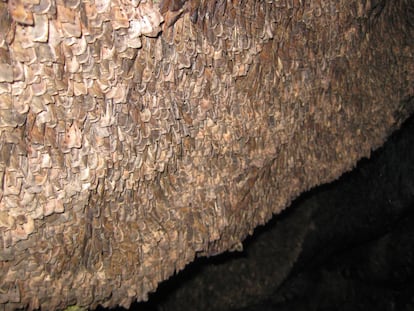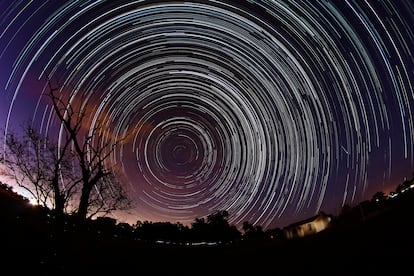Millions of moths use the stars on a journey of more than a thousand kilometers to avoid getting lost.

As the southern hemisphere approaches summer (in December), billions of bogong moths ( Agrotis infusa ) leave the grasslands of southeastern Australia. They fly from various regions of the vast island continent for several nights (they are nocturnal) to a few caves in the Snowy Mountains, more than a thousand kilometers away, fleeing the heat. After spending the summer in dormancy, they return to where they were born to mate and die. What makes this double migration extraordinary is that the moths hatched that spring, so they have never made the journey before. Research published in Nature , the leading scientific journal, shows how they use the stars to navigate at night.
That salmon return to the same river where they were born to breed and die after spending their entire adult life at sea. That turtles return to the same beach where they hatched to lay their eggs. That caribou in northern Canada or wildebeest in East Africa travel thousands of kilometers in a double migration. Or that a small bird like the Arctic tern stands out among migratory birds by breeding in the Arctic and spending the winter in Antarctica, a double journey of 20,000 kilometers, are events that intrigue biologists. But these are species from the highest branches of the tree of life. Invertebrates with navigational abilities are hardly known. The fascinating figure-eight dance of bees is based on the position of the sun. Dung beetles walk in a straight line alongside their dung ball, also guided by the solar orbit. But their mission is to fly for journeys of a few meters or a few kilometers. Monarch butterflies are the only known insects that use the sun in their seasonal migrations between Canada and the United States, all the way to Mexico.
Bogong moths, endemic to South Australia, aren't as pretty a lepidopteran as monarchs, but they're better at navigating. In 2018, a group of researchers discovered that they could sense the Earth's magnetic field . "We discovered that bogong moths are i) magnetosensitive, ii) their magnetic sense is somehow connected to visual landmarks, and iii) this is relevant for maintaining a course/flying in a straight line," replies Lund University biologist David Dreyer about that discovery. Now, Dreyer, along with a range of scientists researching orientation and navigation in the animal kingdom, have discovered that magnetoreception isn't enough; they also use the stars on their journeys.

“In certain areas of the northern hemisphere, with little light pollution, the Milky Way already offers a spectacular spectacle . However, on a moonless night in the Snowy Mountains of Australia, it is even brighter than in the northern hemisphere,” recalls Dreyer, first author of the research published in Nature . “We don't know for sure what features of the sky they use to navigate, but the long axis of the Milky Way or the Carina Nebula [the brightest portion of this barred spiral galaxy] are promising candidates for future follow-up experiments,” he adds. So the bogongs would be guided by stars, with their magnetoreception as a backup system.
To demonstrate these wonders, the researchers captured several hundred moths, some at the beginning of their outward journey to the mountains, others on the return journey, at the end of summer. And they tricked them. They created a flight simulator for them in a room covered with dark felt. As if it were a planetarium, they displayed images of the night sky in front of them. To allow an optical encoder to record their orientation, which it did five times every second, they were mobilized by attaching them to a tungsten rod, which allowed them to fly and orient themselves, but not to move forward. The researchers verified that they oriented their flight according to the position of the stars. In fact, by rotating the night map 180º, the bogongs corrected their position. And when they were presented with a fake map, with the position of the stars and constellations altered, the moths fluttered around in confusion until they came to a standstill.
As in the Northern Hemisphere, the sky changes between spring and autumn, with significant variations in the relative position of the stars. “It seems that moths understand these differences at different times of the year and can therefore migrate in their inherited migratory direction,” explains Eric Warrant, professor of sensory biology also at Lund University and senior author of this research, in an email. “How they manage this difference in the appearance of the sky is still unknown,” he acknowledges.
They also don't know how they adjust their flight to the movement of the stars each night, the so-called stellar rotation, which in the Southern Hemisphere is clockwise, unlike in the Northern Hemisphere. "It could be that moths are able to compensate for the timing of the stars' movements throughout the night, thus maintaining their migratory direction, regardless of the stars' rotational position," Warrant says. If so, it would be the first example of a nocturnal animal capable of doing so. "We know of insects like the monarch butterfly that can compensate for the timing of the sun's position throughout the day, thus maintaining their inherited southwesterly direction toward Mexico during the North American fall," he explains.

It could also be that they use a backup system: “Another possibility is that the moths rely on the constant directional information provided by the Earth's magnetic field and use it to compensate for the rotation of the night sky,” Professor Warrant recalls. Indeed, in the experiments, they observed that, under cloudy skies, the bogongs remained correctly oriented for a time. There is another equally fascinating explanation: “A final possibility is that the moths are able to detect the center of rotation of stars at night and use this to determine south.” It is known that, in the Northern Hemisphere, migratory birds navigate by the position of the North Star, which marks the center of rotation of the stars. It could be that the moths do the same in the south (see image), but the authors acknowledge that bogongs do navigate by the stars, but they do not know the specific mechanism.
To confirm their discovery, the authors of this research recorded the brain activity of these animals, which have a few hundred neurons, while they viewed the starry sky in a flight simulator. This is explained by Andrea Adden, a biologist at the Francis Crick Institute (United Kingdom), co-author of the study and responsible for placing tiny electrodes on 28 neurons in brain regions of the moths believed to be involved in navigation: “By rotating the image of the starry sky over the moth, I could observe a change in the activity of that neuron; for example, the electrical signals could speed up when the moth was facing south relative to the image of the Milky Way and slow down as it moved away from the south,” says Adden. For her, this would indicate that “the neurons process the starry sky in a way that guides the moth during its navigation, something like an internal compass.”
The star compass idea is also supported by Henrik Mouritsen, an expert in animal neurosensory navigation at the University of Oldenburg (Germany). Mouritsen, who has published several papers on the GPS of salmon, turtles, caribou, wildebeest, and migratory birds such as the Arctic tern and monarch butterflies , states in an email that “the bogong moth is the first invertebrate shown to use the starry sky (more specifically, the Milky Way) as a true compass to consistently navigate in a geographic direction over long periods of time.”
And if these same researchers can demonstrate how they adjust their navigation to daily and seasonal changes in the rotation of stars, we would be the first animal to do so. The problem is that bogong moth populations have declined dramatically in recent years, landing on theInternational Union for Conservation of Nature's Red List . This work has underscored the importance of protecting migratory routes and maintaining dark skies free of light pollution .
EL PAÍS





